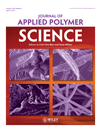Cure kinetics of a glass/epoxy prepreg by dynamic differential scanning calorimetry
Abstract
Dicyandiamide (DICY)-cured epoxy resins are important materials for structural adhesives and matrix resins for fiber-reinforced prepregs. Dynamic differential scanning calorimetry (DSC) with heating rates of 2.5, 5, 10, and 15°C/min was used to study the curing behavior of the epoxy prepreg Hexply 1454 system, which consisted of diglycidyl ether of bisphenol A, DICY, and Urone reinforced by glass fibers. The curing kinetic parameters were determined with three different methods and compared. These were the Kissinger, Ozawa, and Borchardt–Daniels kinetic approaches. The lowest activation energy (76.8 kJ/mol) was obtained with the Kissinger method, whereas the highest value (87.9 kJ/mol) was obtained with the Borchardt–Daniels approach. The average pre-exponential factor varied from 0.0947 × 109 to 2.60 × 109 s−1. The orders of the cure reaction changed little with the heating rate, so the effect of the heating rate on the reaction order was not significant. It was interesting that the overall reaction order obtained from all three methods was nearly constant (≅2.4). There was good agreement between all of the methods with the experimental data. However, the best agreement with the experimental data was seen with the Ozawa kinetic parameters, and the most deviation was seen with the Borchardt kinetic parameters. © 2010 Wiley Periodicals, Inc. J Appl Polym Sci, 2011




